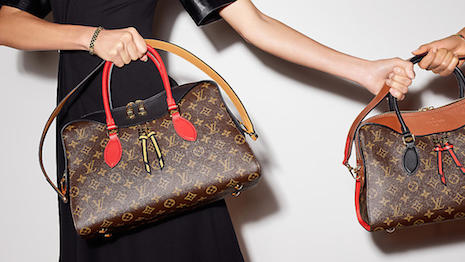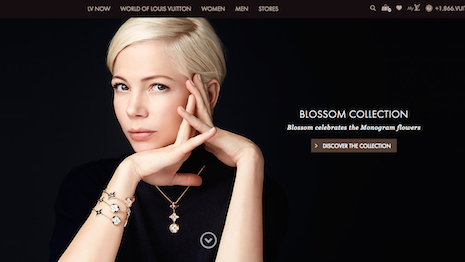 Louis Vuitton's new collection, accenting heritage Monogram canvas with colorful leather details. Credits: Louis Vuitton
Louis Vuitton's new collection, accenting heritage Monogram canvas with colorful leather details. Credits: Louis Vuitton
By Thomas Serrano Admit it. Luxury sure is not what it used to be. We blame the Kardashians. How did this happen? Well, the truth is, it has been a process, and this has been going on for a long time. Let us flash back for a second to 2006 and 2007. Three major cultural moments come to mind: 1. The Devil Wears Prada, the movie based on Lauren Weisberger’s tell-all book about working at Vogue for editor in chief Anna Wintour, is released, starring Anne Hathaway, Meryl Streep and Emily Blunt. The movie was epic, and though the ending is decidedly un-materialistic, back-to-basics and all about the return from luxury to love, the movie has since become a classic, in huge part due to the glitz and glam of all that high fashion. 2. A year later, the book, “Deluxe: How Luxury Lost its Luster,” by Dana Thomas, was released. It was a book that radically rippled through the industry. In it, Ms. Thomas — who had at the time been the cultural and fashion writer for Newsweek in Paris for 12 years – wrote a solid social memoir of fashion, which was as entertaining as it was poignant. It was a call to arms: a declaration of the demise of true luxury. In a nutshell, Ms. Thomas showed what was happening to the luxury industry, calling out “the shift from small family businesses of beautifully handcrafted goods to global corporations selling to the middle market.” 3. In October of that same year, 2007, television channel E! thrusts “Keeping up with the Kardashians” upon the world. Nothing is ever quite the same. Turns out, Dana Thomas was totally right then, and she is completely right today. Her book, written a decade ago, was about how a business that once catered to the wealthy elite went mass-market. Mind you, this was written pre-influencers, pre Facebook, pre-Instagram. It could not be more relevant today. Masses are assets? Although “Deluxe: How Luxury Lost its Luster” quoted Vogue’s Ms. Wintour saying such changes mean that “more people are going to get better fashion” and “the more people who can have fashion, the better,” back then, Ms. Thomas reached a more jaded conclusion. The author wrote: “The luxury industry has changed the way people dress. It has realigned our economic class system. It has changed the way we interact with others. It has become part of our social fabric. “To achieve this,” Ms. Thomas pointed out, “it has sacrificed its integrity, undermined its products, tarnished its history and hoodwinked its consumers. In order to make luxury ‘accessible,’ tycoons have stripped away all that has made it special.” “Luxury has lost its luster,” indeed. We quite agree. In fact, in recent months, both Luxury Daily and Luxury Society lamented in op-eds and reports that luxury brand advertising itself has gone “too corporate” and “too mass” in an attempt to hit ever-higher global sales goals in spite of a challenging market. What the articles referred to was the massification of the luxury message: using sports, influencers and cars to sell watches, jewelry, spirits and fashion. We can understand a house’s heritage in sailing, in equestrian sports, even in the occasional car race. But basketball? Scott Disick? Car-chase movies? What do any of these have to do with luxury? This is our battle cry to change this. We believe it is time for luxury to make a very serious statement by stepping back into that which makes luxury brands luxurious. That is right – we want to Make Luxury Great Again. It is not too late for luxury brands to recover their elite status, but it will not be easy. Here are our top five tips for making luxury great again: 1. Be old High-profile luxury brands such as Louis Vuitton, Hermès and Cartier were founded in the 18th or 19th centuries by artisans dedicated to creating beautiful, finely made wares for the royal court in France. It is impossible to replicate legacy, origin and tradition. That, above all, is your story. Here is where we also strongly endorse manufacturing at home. Asian consumers are not the only one who care about origin. We do, too.
 Actress Michelle Williams in the Louis Vuitton campaign for its Blossom jewelry collection. Credits: Louis Vuitton
Actress Michelle Williams in the Louis Vuitton campaign for its Blossom jewelry collection. Credits: Louis Vuitton
 Cartier's new Love collection of jewelry. Credits: Cartier
Cartier's new Love collection of jewelry. Credits: Cartier
 Still from Hermès' humorous video on how to tie a knot. Credits: Hermès
Still from Hermès' humorous video on how to tie a knot. Credits: Hermès
